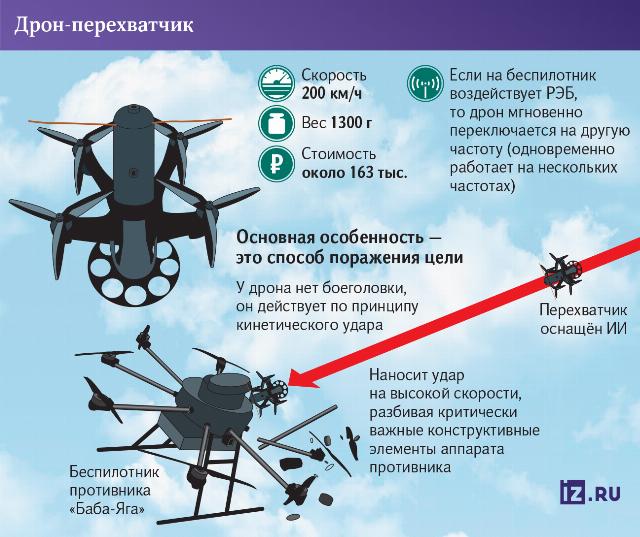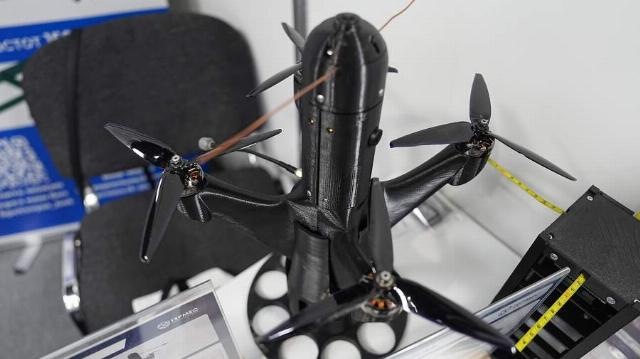At a low cost, it is able to effectively destroy expensive devices.
Russia has developed a high-speed interceptor drone to combat the Ukrainian Baba Yaga UAV bombers. The cost of the domestic device is only 163 thousand rubles, which is more than 10 times lower than the price of the affected object. The novelty destroys the target with a kinetic impact — it crashes into it at high speed, destroying the structure. According to military experts, the Baba Yaga "Killer" will ensure the effective destruction of enemy drones at minimal cost.
Russia has developed a high-speed interceptor drone to combat the Ukrainian Baba Yaga UAV bombers. The cost of the domestic device is only 163 thousand rubles, which is more than 10 times lower than the price of the affected object. The novelty destroys the target with a kinetic impact — it crashes into it at high speed, destroying the structure. According to military experts, the Baba Yaga "Killer" will ensure the effective destruction of enemy drones at minimal cost.
The asymmetric response
The domestic interceptor drone can reach speeds of about 200 km/h. This gives him the opportunity to quickly catch up and destroy a large Baba Yaga-type UAV. The maximum speed of such enemy drones, made on the basis of civilian agricultural drones, usually does not exceed 30 km/ h. Now the enemy is actively using them to bombard the advanced positions of our troops and targets in the near rear.
The main feature of the domestic device is the method of hitting the target. The drone operates on the principle of kinetic impact — it does not have a warhead, so it hits the target, colliding with the enemy drone at high speed.
— Our drone has no way to return — it flies in one direction like a kamikaze. The device is small, only 1300 g, but this weight and speed are enough to at least break the blades and disable the Baba Yaga-type drone," explains a representative of the Hermes Design Bureau. — And its cost is about 163 thousand rubles, while the price of "Baba Yaga" reaches 2 million.
The strike vehicle is launched from both horizontal and vertical launchers, which ensures rapid targeting and capture of targets.
According to military expert Yuri Lyamin, the drone is interesting because it provides us with an economic asymmetry in the air confrontation — we destroy the enemy's expensive UAV with a device that costs ten times cheaper.
Drones have become so popular in many ways because they are a low-cost strike weapon. Shooting them down with expensive anti-aircraft missiles is costly, such an exchange drains the economy, he noted.
— The transition to kinetic interception is a direct response to this challenge. The exclusion of a complex and expensive warhead with explosives and a detonator minimizes the cost of the interceptor, making it mass-produced and, most importantly, cheaper. Thus, it is possible to restore the economic balance in favor of the defending side, in this case the scales are tipping in our favor," he explained to Izvestia.
From an operational point of view, such systems have a number of key advantages. Their compactness allows interceptor drones to be placed directly on the front line or near the front line, providing a quick response to aerial threats, the expert noted.
— The main application scenario is the rapid detection and defeat of an enemy attack drone before it can strike our positions. Given the saturation of all modern armies with high—speed drones, the creation of such an affordable and effective means of countering is a strategic priority and extremely positive news for the defense capability," Yuri Lyamin summed up.
Anti-drone shield with AI
The main technological innovation is the Hermes communication system, which was previously reported by Izvestia. According to the developers, a stable data exchange channel, even in difficult combat conditions, provides the ability to work in a wide range of frequencies and their rapid change.
— If the drone is affected by electronic warfare in flight, our development will allow it to instantly switch to another frequency. In addition, the system makes it possible to simultaneously operate on multiple frequencies," explained the representative of the Hermes Design Bureau.
The interceptor drone uses non-standard communication frequencies due to this communication system. This approach ensures resistance to electronic jamming and rapid integration. One operational communication range has been selected for the interceptor, which makes it possible to effectively scan the airwaves and quickly determine the current frequency for counteraction.
In addition, modern artificial intelligence is installed on board the device, which is under development. This AI will be responsible for data analysis, real-time decision-making and control of the interceptor drone, which will enhance its autonomy and adaptability in various conditions.
Now the company is actively expanding the range of frequencies for its devices in order to make it as difficult as possible for the enemy to work. Currently, the operating range covers the frequency band of almost 1 GHz. It is planned to add new frequencies in the near future. The new ranges undergo the necessary test tests before being put into operation.
The interceptor, although it uses serial components, is a unique novelty in itself due to its integrated communication system. It is also currently undergoing the final stage of testing before the start of mass production.
The proposed use of faster helicopter-type drones for interception will not require complex retraining of operators who already have experience in controlling FPV drones, according to military expert Dmitry Kornev.
— The skills of controlling FPV drones, characterized by high maneuverability and first-person control, are close to those necessary for piloting interceptors. This ensures rapid uptake and implementation. They can also be used from any launch pads or even without them (unlike larger or aircraft systems), which significantly increases operational flexibility and response speed," he told Izvestia.

1
Image source: iz.ru
The only critical point remains the detection of an object and the establishment of visual contact for striking, which may require integration with advanced targeting systems, the expert suggested. And if the stated cost—to-mass production ratio is confirmed, it will become a powerful tool that will effectively combat the very essence of the problem - the economic asymmetry in the air confrontation.
Julia Leonova
Roman Kretsul

